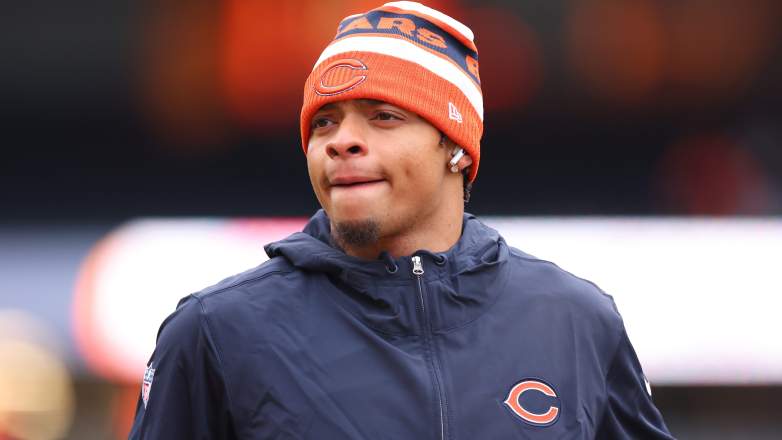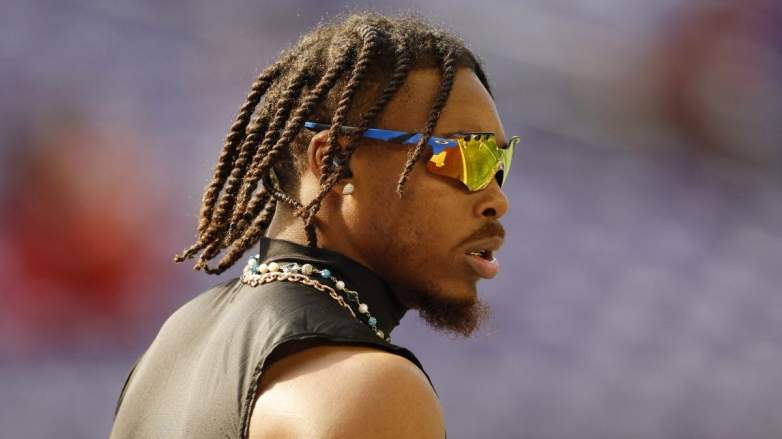
Getty Quarterback Justin Fields, formerly of the Chicago Bears.
The NFC North Division rivalry between the Chicago Bears and Minnesota Vikings could have added an extra level of intrigue if the Justin Fields trade saga had played out a little differently.
Chicago was primed to deal Fields for months after the franchise locked into the No. 1 overall pick in what is one of the best draft classes for quarterback talent in recent memory. But Ryan Poles wanted to deliver on his intention to “do right” by Fields, which meant dealing him as quickly as possible to one of his desired destinations.
According to Brooke Pryor of ESPN, Fields gave Poles a list of four teams. One was the Pittsburgh Steelers, where the QB ultimately landed. Another was the Vikings.
“The Steelers were one of four teams on Fields’ radar prior to the start of free agency, along with the Vikings, Raiders and Falcons, a source familiar with Fields’ thinking said,” Pryor wrote on Friday, March 29.
Vikings Will Spend Considerably More Draft Capital on Rookie QB Than They Would Have on Justin Fields

GettyQuarterback Justin Fields, formerly of the Chicago Bears.
It is unclear if the Vikings ever engaged in talks of any kind with the Bears as to a potential deal for Fields, though it strains credulity to believe that general manager Kwesi Adofo-Mensah and head coach Kevin O’Connell weren’t at least aware of Fields’ interest in Minnesota as a top-four destination.
The math on a deal for Fields would have been complicated for the Vikings, though the cost on the front end would undoubtedly have been lower than what the team is going to spend on securing a quarterback in the coming NFL draft.
To land Fields, Minnesota presumably would have needed to best the Steelers’ offer. However, they could have accomplished that by offering Chicago just a fifth-round pick with conditions that bumped it up to a fourth-rounder. Pittsburgh paid the Bears a sixth-round pick in 2025, which bumps to a fourth-rounder if Fields plays 51% of the team’s offensive snaps next season.
Instead, Minnesota traded two seconds and a sixth to the Houston Texans earlier this month to acquire the No. 23 overall pick. Most analysts expect the Vikings did so because they intend to package that selection, along with their No. 11 pick, to try and move up into the top five and draft a prospect like Drake Maye or J.J. McCarthy.
Doing so could ultimately cost Minnesota a 2025 first-rounder as well, depending on how high the Vikings attempt to trade and what competition exists for that draft position.
Vikings Risk Alienating Justin Jefferson by Passing on Trade With Bears for Justin Fields

GettyWide receiver Justin Jefferson of the Minnesota Vikings.
As for how Minnesota’s QB plans will impact the pecking order in the NFC North, that remains a very open question. As of today, Sam Darnold is the starter in Minnesota.
That doesn’t bode well for a Vikings team that has to contend with the Bears, who have made considerable moves already this offseason and are poised to select Caleb Williams first overall before drafting another elite prospect with the 9th pick. The Detroit Lions and Green Bay Packers are also teams on the rise, as each made the playoffs last year and won three postseason games between them.
Minnesota’s play at quarterback is also risky due to its implications on the future of All-Pro wide receiver Justin Jefferson. Jefferson is eligible for an extension, which could easily reset the market and make history as the largest wideout contract in NFL history.
Jefferson lobbied for the Vikings to draft Fields back in 2021, calling the then-Ohio State QB “dominant” during an episode of “The Herd” with Colin Cowherd.
“We have to build on for after Kirk,” Jefferson said. “Having Justin Fields brings a little more pressure to other teams by having a dominant quarterback — like he is.”
If Minnesota lands a dominant type of quarterback somewhere in the upcoming draft, then the team made the right call on Fields and Jefferson should be happy and end up re-signing. However, if the Vikings miss, they may regret passing on Fields — especially if it results in Jefferson’s departure and the subsequent changing of regimes, which Minnesota navigated just two years ago.
Comments